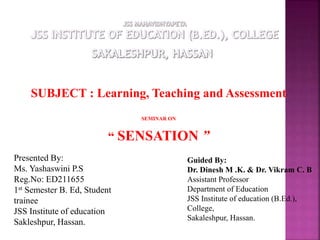
Lta seminar sensation
- 1. SUBJECT : Learning, Teaching and Assessment SEMINAR ON “ SENSATION ” Presented By: Ms. Yashaswini P.S Reg.No: ED211655 1st Semester B. Ed, Student trainee JSS Institute of education Sakleshpur, Hassan. Guided By: Dr. Dinesh M .K. & Dr. Vikram C. B Assistant Professor Department of Education JSS Institute of education (B.Ed.), College, Sakaleshpur, Hassan.
- 2. SL. NO TITLES 1 Introduction 2 Definition 3 Types of sensation 4 Elements of sensation 5 Conclusion 6 Reference
- 3. Any experience that takes place through a sense organ is called Sensation. Sensation is also called as the gate ways of knowledge, because all our knowledge is based upon the functioning of sense organs. Sensation is the simple and most elementary process, which creates the desire to work for something and how to know something based on previous experiences. It is purely sensory knowledge, which does not have any relationship with any knowledge or awareness. A sensation does not help us acquiring complete knowledge.
- 4. The impressions received through the sense organs are called sensations – Mathur. A Sensations are first things in the way of consciousness – James. Sensation is defined as the simplest of all conscious experience – Duglas and Halland. Ssensation is the process of receiving, translating and transmitting information to the brain from the external and internal environment – Huffman.
- 5. We can divide easily the sensation process into five categories on the basis of sense organs. Visual Sensation Aauditory Sensation Olfactory Sensation Taste Sensation Tactual Sensation
- 6. The eye is the organ of our sensation of sight. It occupies the first place among the sense-organs and is called “the queen of senses”. The stimulus for the visuall sensation is rays of light. The light-enter the eye through cornea. After passingg through the pupil and the lenses they reach retina: From the retiria the optic nerve carries the visual impulse to the brain, and we have the sensation of sight. The visual sensation occupies the highest place among sensations. It is the most refined sensation. It is important to mark two stages in the development, of sight sensation. These are Brightness sensations and Colour sensations. White, Black and Grey are brightness sensations and belong to the most primitive and earliest sensations. The colour sensations are those of blue; green, red and yellow. They come at a later stage in the development of the eye.
- 7. The ear is the organ of our-auditory sensations. The stimulus for sound sensation consists of the vibration or motion in the particles of air. The ear consists of three parts : (i) The external ear: It collects the sound waves which are carried by the auditory canal to the central brain. (ii) The middle ear: It is a drum-shaped cavity from where certain bones oscillate and produce vibrations in the ear. (iii) The inner ear: It sends nerve impulse to the brain-where the sensation arises.
- 8. The nose is the organ of smell. The appropriate stimuli for the sensation of smell-are the gaseous substances included in the air. The olfactory nerve in the upper cavity of the nose plays an active role in smell sensation. The olfactory nerve carries the odorous impulse to the brain where brain where the sensation of smell takes place. The important points to be noted about smell sensation are: 1. The sensation of smell is useful in order to know the kind of surroundings we are placed in. 2. The sensation of smell is connected with the sensation of taste. We can judge the taste of a thing by smelling its oders
- 9. The tongue is the organ of taste. The sensation of taste can be stimulated only by fluids. Solid objects must first dissolve themselves before they can produce any taste sensation. At the back of the tongue there are taste bulbs or ‘taste buds’ each of which contains a number of taste cells. When we put anything on the tongue, its particles come in contact with these cells, and the sensation is caused Thus, the ‘taste buds are the receptors of stimuli. There are only four basic tastes : sweet, bitter, sour, and selfish.
- 10. The main elements of the sensation process are given below: Quality: The nature of each sensation is different from other. Every type of sensation has got its own special quality or characteristics. This quality of the sensation helps us to distinguish one from other. For example, green sensation of eye, cold sensation of skin. Intensity: Sensation differs in respect of its intensity. If two sounds are created at once, one will be the intenser than other. It is differs in same type of sense or among the different types of sensations. Extensity: Extensity refers the extension in space. Each sensation has its extensity. The vaster the stimulus, the more extensive the sensation. The extensity is not true for all the types of sensation, but restricted to certain. Duration: Every sensation has its duration or lasts for certain time. The auditory sensation of aero plane sound is more extensive than the sound of the calling bell. Clarity: Every sensation has got clarity. The sensation which lasts for longer period becomes clearer than the sensation lasts for shorter period.
- 11. Our sensory organs react to the environment. our brain interprets sensory information. Our impressive sensory ability allow us to experience the most enjoyable and most miserable experiences, as well as everything in between , our eyes, ears, nose, tongue and skin provide an interface for the brain to interact with the world around us.
- 12. Dr. H.V. Vamadevappa.,(2016), Psychology of learning and instruction. Pp: 92-100. https://www.slideshare.net